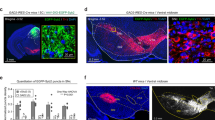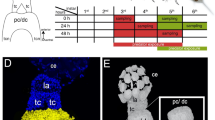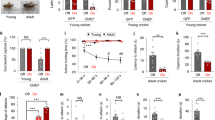Abstract
Predatory hunting plays a fundamental role in animal survival. Little is known about the neural circuits that convert sensory cues into neural signals to drive this behavior. Here we identified an excitatory subcortical neural circuit from the superior colliculus to the zona incerta that triggers predatory hunting. The superior colliculus neurons that form this pathway integrate motion-related visual and vibrissal somatosensory cues of prey. During hunting, these neurons send out neural signals that are temporally correlated with predatory attacks, but not with feeding after prey capture. Synaptic inactivation of this pathway selectively blocks hunting for prey without impairing other sensory-triggered behaviors. These data reveal a subcortical neural circuit that is specifically engaged in translating sensory cues into neural signals to provoke predatory hunting.
This is a preview of subscription content, access via your institution
Access options
Access Nature and 54 other Nature Portfolio journals
Get Nature+, our best-value online-access subscription
$29.99 / 30 days
cancel any time
Subscribe to this journal
Receive 12 print issues and online access
$209.00 per year
only $17.42 per issue
Buy this article
- Purchase on Springer Link
- Instant access to full article PDF
Prices may be subject to local taxes which are calculated during checkout






Similar content being viewed by others
Data availability
The data that support the findings of this study are available from the corresponding author upon request.
Code availability
The MATLAB code for data analyses is available from the corresponding author upon request.
References
Ewert, J. P. Neural correlates of key stimulus and releasing mechanism: a case study and two concepts. Trends Neurosci. 20, 332–339 (1997).
Gahtan, E., Tanger, P. & Baier, H. Visual prey capture in larval zebrafish is controlled by identified reticulospinal neurons downstream of the tectum. J. Neurosci. 25, 9294–9303 (2005).
Bianco, I. H. & Engert, F. Visuomotor transformations underlying hunting behavior in zebrafish. Curr. Biol. 25, 831–846 (2015).
Butler, K. Predatory behavior in laboratory mice: strain and sex comparisons. J. Comp. Physiol. Psychol. 85, 243–249 (1973).
Anjum, F., Turni, H., Mulder, P. G., van der Burg, J. & Brecht, M. Tactile guidance of prey capture in etruscan shrews. Proc. Natl Acad. Sci. USA 103, 16544–16549 (2006).
Hoy, J. L., Yavorska, I., Wehr, M. & Niell, C. M. Vision drives accurate approach behavior during prey capture in laboratory mice. Curr. Biol. 26, 3046–3052 (2016).
Kim, C. K., Adhikari, A. & Deisseroth, K. Integration of optogenetics with complementary methodologies in systems neuroscience. Nat. Rev. Neurosci. 18, 222–235 (2017).
Luo, L., Callaway, E. M. & Svoboda, K. Genetic dissection of neural circuits: a decade of progress. Neuron 98, 256–281 (2018).
Seabrook, T. A., Burbridge, T. J., Crair, M. C. & Huberman, A. D. Architecture, function, and assembly of the mouse visual system. Annu. Rev. Neurosci. 40, 499–538 (2017).
Cang, J., Savier, E., Barchini, J. & Liu, X. Visual function, organization, and development of the mouse superior colliculus. Annu. Rev. Vis. Sci. 4, 239–262 (2018).
Gandhi, N. J. & Katnani, H. A. Motor functions of the superior colliculus. Annu. Rev. Neurosci. 34, 205–231 (2011).
Basso, M. A. & May, P. J. Circuits for action and cognition: a view from the superior colliculus. Annu. Rev. Vis. Sci. 3, 197–226 (2017).
Wang, L., Sarnaik, R., Rangarajan, K., Liu, X. & Cang, J. Visual receptive field properties of neurons in the superficial superior colliculus of the mouse. J. Neurosci. 30, 16573–16584 (2010).
Hong, Y. K., Kim, I. J. & Sanes, J. R. Stereotyped axonal arbors of retinal ganglion cell subsets in the mouse superior colliculus. J. Comp. Neurol. 519, 1691–1711 (2011).
Gale, S. D. & Murphy, G. J. Distinct representation and distribution of visual information by specific cell types in mouse superficial superior colliculus. J. Neurosci. 34, 13458–13471 (2014).
Dräger, U. C. & Hubel, D. H. Responses to visual stimulation and relationship between visual, auditory, and somatosensory inputs in mouse superior colliculus. J. Neurophysiol. 38, 690–713 (1975).
Meredith, M. A. & Stein, B. E. Interactions among converging sensory inputs in the superior colliculus. Science 221, 389–391 (1983).
Cohen, J. D., Hirata, A. & Castro-Alamancos, M. A. Vibrissa sensation in superior colliculus: wide-field sensitivity and state-dependent cortical feedback. J. Neurosci. 28, 11205–11220 (2008).
Cohen, J. D. & Castro-Alamancos, M. A. Behavioral state dependency of neural activity and sensory (whisker) responses in superior colliculus. J. Neurophysiol. 104, 1661–1672 (2010).
Furigo, I. C. et al. The role of the superior colliculus in predatory hunting. Neuroscience 165, 1–15 (2010).
Favaro, P. D. et al. The influence of vibrissal somatosensory processing in rat superior colliculus on prey capture. Neuroscience 176, 318–327 (2011).
Allen, W. E. et al. Thirst-associated preoptic neurons encode an aversive motivational drive. Science 357, 1149–1155 (2017).
Boyden, E. S., Zhang, F., Bamberg, E., Nagel, G. & Deisseroth, K. Millisecond-timescale, genetically targeted optical control of neural activity. Nat. Neurosci. 8, 1263–1268 (2005).
Park, S. G. et al. Medial preoptic circuit induces hunting-like actions to target objects and prey. Nat. Neurosci. 21, 364–372 (2018).
Tervo, D. G. et al. A designer AAV variant permits efficient retrograde access to projection neurons. Neuron 92, 372–382 (2016).
Westby, G. W., Keay, K. A., Redgrave, P., Dean, P. & Bannister, M. Output pathways from the rat superior colliculus mediating approach and avoidance have different sensory properties. Exp. Brain Res. 81, 626–638 (1990).
Shang, C. et al. Brain circuits. A parvalbumin-positive excitatory visual pathway to trigger fear responses in mice. Science 348, 1472–1477 (2015).
Gunaydin, L. A. et al. Natural neural projection dynamics underlying social behavior. Cell 157, 1535–1551 (2014).
Li, Y. et al. Hypothalamic circuits for predation and evasion. Neuron 97, 911–924.e5 (2018).
Coizet, V. et al. Short-latency visual input to the subthalamic nucleus is provided by the midbrain superior colliculus. J. Neurosci. 29, 5701–5709 (2009).
Watson, G. D., Smith, J. B. & Alloway, K. D. The zona incerta regulates communication between the superior colliculus and the posteromedial thalamus: implications for thalamic interactions with the dorsolateral striatum. J. Neurosci. 35, 9463–9476 (2015).
Kita, T., Shigematsu, N. & Kita, H. Intralaminar and tectal projections to the subthalamus in the rat. Eur. J. Neurosci. 44, 2899–2908 (2016).
Mitrofanis, J. Some certainty for the “zone of uncertainty”? Exploring the function of the zona incerta. Neuroscience 130, 1–15 (2005).
Fife, K. H. et al. Causal role for the subthalamic nucleus in interrupting behavior. eLife 6, e27689 (2017).
Govorunova, E. G., Sineshchekov, O. A., Janz, R., Liu, X. & Spudich, J. L. Natural light-gated anion channels: a family of microbial rhodopsins for advanced optogenetics. Science 349, 647–650 (2015).
Zhang, X. & van den Pol, A. N. Rapid binge-like eating and body weight gain driven by zona incerta GABA neuron activation. Science 356, 853–859 (2017).
Zhao, Z.-d. et al. Zona incerta GABAergic neurons integrate prey-related sensory signals and induce an appetitive drive to promote hunting. Nat. Neuro. https://doi.org/10.1038/s41593-019-0404-5 (2019).
Roseberry, T. K. et al. Cell-type-specific control of brainstem locomotor circuits by basal ganglia. Cell 164, 526–537 (2016).
Caggiano, V. et al. Midbrain circuits that set locomotor speed and gait selection. Nature 553, 455–460 (2018).
Comoli, E. et al. Segregated anatomical input to sub-regions of the rodent superior colliculus associated with approach and defense. Front. Neuroanat. 6, 9 (2012).
Meredith, M. A. & Stein, B. E. Descending efferents from the superior colliculus relay integrated multisensory information. Science 227, 657–659 (1985).
Stein, B. E. & Meredith, M. A. Multisensory integration. neural and behavioral solutions for dealing with stimuli from different sensory modalities. Ann. NY Acad. Sci. 608, 51–65 (1990).
Kleinfeld, D., Ahissar, E. & Diamond, M. E. Active sensation: insights from the rodent vibrissa sensorimotor system. Curr. Opin. Neurobiol. 16, 435–444 (2006).
Urbain, N. & Deschênes, M. Motor cortex gates vibrissal responses in a thalamocortical projection pathway. Neuron 56, 714–725 (2007).
Liu, K. et al. Lhx6-positive GABA-releasing neurons of the zona incerta promote sleep. Nature 548, 582–587 (2017).
Han, W. et al. Integrated control of predatory hunting by the central nucleus of the amygdala. Cell 168, 311–324.e18 (2017).
Ricardo, J. A. Efferent connections of the subthalamic region in the rat. II. The zona incerta. Brain Res. 214, 43–60 (1981).
Evans, D. A. et al. A synaptic threshold mechanism for computing escape decisions. Nature 558, 590–594 (2018).
Qiao, H., Li, C., Yin, P. J., Wu, W. & Liu, Z. Y. Human-inspired motion model of the upper limb with fast response and learning ability—a promising direction for robot system and control. Assem. Autom. 36, 97–107 (2016).
Yin, P. et al. A novel biologically inspired visual cognition model: automatic extraction of semantics, formation of integrated concepts, and reselection features for ambiguity. IEEE Trans. Cogn. Dev. Syst. 10, 420–431 (2018).
Vong, L. et al. Leptin action on GABAergic neurons prevents obesity and reduces inhibitory tone to POMC neurons. Neuron 71, 142–154 (2011).
Taniguchi, H. et al. A resource of Cre driver lines for genetic targeting of GABAergic neurons in cerebral cortex. Neuron 71, 995–1013 (2011).
López-Bendito, G. et al. Preferential origin and layer destination of GAD65-GFP cortical interneurons. Cereb. Cortex 14, 1122–1133 (2004).
Yilmaz, M. & Meister, M. Rapid innate defensive responses of mice to looming visual stimuli. Curr. Biol. 23, 2011–2015 (2013).
Wei, P. et al. Processing of visually evoked innate fear by a non-canonical thalamic pathway. Nat. Commun. 6, 6756 (2015).
Huang, L. et al. A retinoraphe projection regulates serotonergic activity and looming-evoked defensive behaviour. Nat. Commun. 8, 14908 (2017).
Shang, C. et al. Divergent midbrain circuits orchestrate escape and freezing responses to looming stimuli in mice. Nat. Commun. 9, 1232 (2018).
Chen, T. W. et al. Ultrasensitive fluorescent proteins for imaging neuronal activity. Nature 499, 295–300 (2013).
Liu, Z. et al. IGF1-dependent synaptic plasticity of mitral cells in olfactory memory during social learning. Neuron 95, 106–122.e5 (2017).
Acknowledgements
The authors thank T. Südhof, K. Deisseroth, L. Luo, M. Luo and M. He for providing the plasmids and mouse lines. They also thank members of the Neuroscience Pioneer Club for valuable discussions. This work was supported by the National Natural Science Foundation of China (31671095, 31422026, 81471311, 31771150 and 91632301) and Startup Funding at NIBS. All data are archived at the NIBS.
Author information
Authors and Affiliations
Contributions
P.C. conceived the study. C.S. performed the injections and fiber implantations. C.S., A.L. Z.X. and Y.L. performed the behavioral tests. C.S., Z.X. and A.L. performed the fiber photometry recording. C.S. Z.X., M.H. and A.L. conducted the histological analyses. C.S. and Z.C. performed slice physiology. W.S. and Y.W. provided the reagents. D.L., C.S., A.L., Z.C. and P.C. analyzed the data. P.C. wrote the manuscript.
Corresponding author
Ethics declarations
Competing interests
The authors declare no competing interests.
Additional information
Journal peer review information: Nature Neuroscience thanks Jennifer Hoy, Daesoo Kim, and the other, anonymous, reviewer(s) for their contribution to the peer review of this work.
Publisher’s note: Springer Nature remains neutral with regard to jurisdictional claims in published maps and institutional affiliations.
Supplementary information
Supplementary Video 1
Prey–predator distance measurement during predatory hunting. This movie shows the video taken by the overhead camera. The distance between prey (a cockroach) and predator (an example WT mouse) is continuously measured and shown with a green line between the centroids of the prey and predator. The time course of prey–predator distance (PPD) is plotted in real time during predatory hunting.
Supplementary Video 2
Predatory jaw attacks during predatory hunting. This movie shows the videos taken by the two horizontal cameras. The jaw attacks of the example WT mouse are marked with yellow vertical lines during its predatory hunting. Although the mouse also uses its paws to attack the cockroach, the frequency of paw attack is much lower than that of jaw attack.
Supplementary Video 3
Optogenetic activation of SC–S pathway promotes predatory hunting. By comparing the performance of the same mouse in laser-off phase (00:01–00:36) and in laser-on phase (00:39–01:10), this movie shows that optogenetic activation of SC–S pathway increases the efficiency of predatory hunting.
Supplementary Video 4
Activation of SC–S pathway provoked hunting without inducing food consumption. This movie shows that photostimulation of SC–S pathway specifically provoked hunting behavior without inducing food consumption when food pellet and prey were simultaneously present in the arena.
Supplementary Video 5
Activation of SC–S pathway provoked hunting without inducing social aggression. This movie shows that photostimulation of SC–S pathway specifically provoked hunting behavior without inducing attacks to social target when conspecifics and prey were simultaneously present in the arena.
Supplementary Video 6
In the absence of prey, activation of SC–S pathway induced hunting-related behavioral actions. This movie shows that, in an arena with corn-cob bedding but without prey, photostimulation of SC–S pathway induced hunting-related behavioral actions. This movie was captured with a high-speed camera (160 frames/s).
Supplementary Video 7
Effects of inactivation of SC–S pathway on predatory hunting. By comparing the performance of mice without (Ctrl mouse) or with (TeNT mouse) synaptic inactivation of SC–S pathway, this movie shows that inactivation of SC–S pathway impairs predatory hunting.
Supplementary Video 8
Effects of inactivation of SC–S pathway on visually triggered defensive behavior. By comparing the performance of mice without (Ctrl mouse) or with (TeNT mouse) synaptic inactivation of SC–S pathway, this movie shows that inactivation of SC–S pathway does not alter visually triggered defensive behavior.
Supplementary Video 9
Mouse strongly prefers to chase and attack a moving cockroach rather than a stationary one. In this movie, two cockroaches were simultaneously introduced to the mouse in the arena. One cockroach freely moved, the other was stationary in paralysis. The mouse readily chased and attacked the moving cockroach and ignored the stationary cockroach.
Supplementary Video 10
GCaMP signals of SC–S pathway in parallel with predatory hunting. This movie shows predatory hunting of an example mouse displayed in parallel with the trace of GCaMP signal and the time course of jaw attacks. It can be observed that the peaks of GCaMP signal is temporally matched with the jaw attacks of the mouse.
Supplementary Video 11
GCaMP signals of SC–S pathway during investigation of a textured object. This movie shows the trace of GCaMP signal in parallel with the investigation of a textured object (wood cube). It can be observed that the peaks of GCaMP signal is temporally matched with the vibrissal touch to the object.
Supplementary Video 12
S-projecting SC neurons are activated when the mouse attacks the prey. In this movie, GCaMP signal of an S-projecting SC neuron is displayed in parallel with jaw attacks during predatory hunting for a restrained prey. Note that S-projecting SC neurons are activated when the mouse attacks the prey.
Supplementary Video 13
MLR-projecting SC neurons are activated when the mouse starts to approach the prey. In this movie, GCaMP signal of MLR-projecting SC neurons is displayed in parallel with jaw attacks during predatory hunting for a restrained prey. Note that MLR-projecting SC neurons are activated when the mouse starts to approach the prey.
Rights and permissions
About this article
Cite this article
Shang, C., Liu, A., Li, D. et al. A subcortical excitatory circuit for sensory-triggered predatory hunting in mice. Nat Neurosci 22, 909–920 (2019). https://doi.org/10.1038/s41593-019-0405-4
Received:
Accepted:
Published:
Issue Date:
DOI: https://doi.org/10.1038/s41593-019-0405-4
This article is cited by
-
A primary sensory cortical interareal feedforward inhibitory circuit for tacto-visual integration
Nature Communications (2024)
-
Neural mechanisms for the localization of unexpected external motion
Nature Communications (2023)
-
Neural Circuit Mechanisms Involved in Animals’ Detection of and Response to Visual Threats
Neuroscience Bulletin (2023)
-
Somatostatin-Positive Neurons in the Rostral Zona Incerta Modulate Innate Fear-Induced Defensive Response in Mice
Neuroscience Bulletin (2023)
-
Neurocircuitry of Predatory Hunting
Neuroscience Bulletin (2023)



